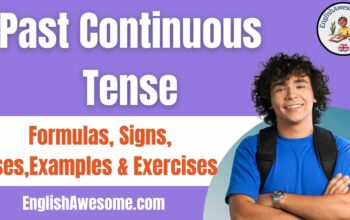Introduction
Present Continuous Tense is used for actions going on in the moment of speaking and for actions taking place only for a short period of time. It is also used to express development and actions that are arranged for the near future.
⏩ Sign Up to Get Bonus
Present continuous is also known as present progressive.
Structure of Present Continuous Tense
POSITIVE FORM (+) :
- Subject + BE ( am / is / are ) + Verb-ING
Examples:
- She is watching TV now.
NEGATIVE FORM (-) :
- Subject + BE ( am / is / are ) + NOT + Verb-ING

Examples:
- She is not doing his homework now.
QUESTION FORM (?) :
- BE ( am / is / are ) + Subject + Verb-ING
Examples:
- Is she studying English?
NEGATIVE QUESTION FORM (?):
- BE ( am / is / are ) + NOT + Subject + Verb-ING
| POSITIVE (+) | NEGATIVE (-) | POSITIVE QUESTION | NEGATIVE QUESTION |
| He is working | He is not working | Is he working | Isn’t he working |
| She is working | She is not working | Is she working | Isn’t she working |
| It is working | It is not working | Is it working | Isn’t it working |
| I am working | I am not working | Am I working | Aren’t I working |
| You are working | You are not working | Are you working | Aren’t you working |
| We are working | We are not working | Are we working | Aren’t we working |
| They are working | They are not working | Are they working | Aren’t they working |
Note: Be aware of the use of the first individual person ‘ I ‘.
We use ‘ I ‘ in a negative question form ‘ Aren’t I’ instead of ‘ Am not I ‘.
Present Continuous Tense Uses
1. Present Continuous Tense expresses the idea that something is happening now, at this moment.
Examples:
- She is listening to the music now.
- We are learning English at this moment.
- My mother is cooking dinner in the kitchen now.
- The gardener is working in the garden at this time.
- At present, children are doing a lot of things that can not be done before.
- She is having breakfast at the moment.
- Look! A car is coming.
- While you are studying, I will make a cake.
- We are currently looking for individuals who have experience in customer service.
- We will rent a flat but for the time being, we are staying at our friend’s house.
- The children are playing football now.
2. Sometimes Present Continuous Tense expresses longer actions not at the moment but in progress. ‘Now’ as a time marker in this situation means “this second,” “today,” “this month,” “this year,” “this century” and so on.
Examples:
- She is studying to become a science teacher.
- We are working on a new project.
- I am learning to play guitar.
3. Present Continuous Tense is used to indicate that something will or will not happen in the near future.
Examples:
- You are starting work tomorrow.
- My sister is coming with us to the party tonight.
- I am talking to the teacher after this lesson.
4. Present Continuous Tense used with “always’’, ‘’constantly’’, ‘’ forever’’ expresses the idea that something often happens in a negative sense. In other words, we use to complain.
Examples:
- She is always talking.
- These students are constantly complaining about everything.
- You are always coming to work late. You must wake up early.
- He is forever speaking. Someone should silence him.
Notice: Some verbs are not used with Present Continuous Tense. These verbs are called “state verbs”.
Present continuous tense shows that an action is done physically and visually. Therefore, abstract meaningful expressions such as abstract thinking, love, understanding, possessing can not be used in continuous (be + -ing) construction. These things are expressed by Simple Tense.
Examples:
- I am understanding you ‘ is WRONG
- I understand ‘ is TRUE
- He is hating Math ‘ is WRONG
- He hates math ‘ is TRUE
Recognition of Present Continuous Tense
The sentence contains the following words:
- Now
- Right now
- Listen!
- At the moment
- At present
- Look!
- Watch out!
- Be quiet!
- Currently
- Fort he time being now
- While/When
Note: Do not use this tense with cognitive and perceptual verbs such as: be, understand, know, like, want, see, hear, glance, feel, think, smell, love, hate, realize, seem, remember, forget, etc.
Lesson: Present Perfect Tense
Above is all helpful information about it. We wish you all good study!
In addition, you can refer such as English stories, grammar, … are constantly updated on Englishtivi.com.
Subscribe to the English tivi channel on Youtube to improve your English learning skills!





